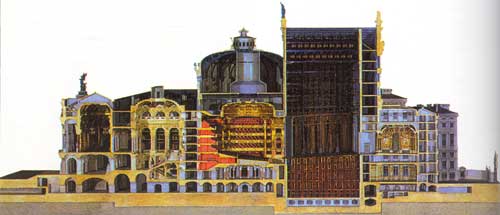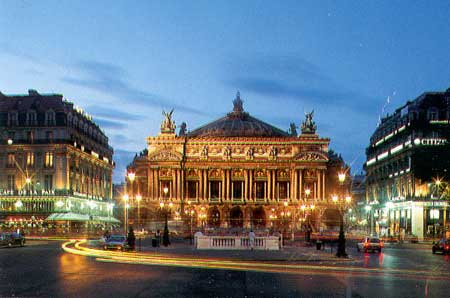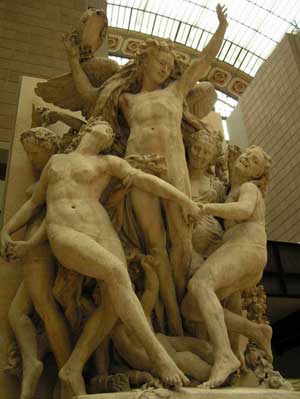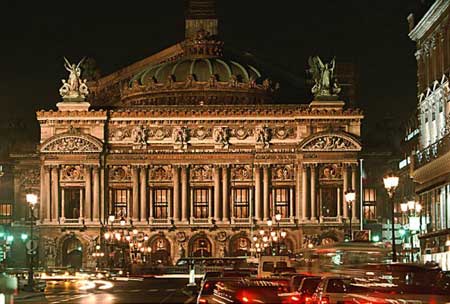-
Construction Period: 1861 – 1875
-
Location: Paris, France
The Opéra House, now officially known as Palais Garnier in honor of its architect, is one of the most iconic buildings in Paris. When Napoleon III and Baron Haussmann planned the city in 1852, they envisioned grand boulevards and straight vistas, with a central building that aligned with the overall design. The Opéra House is situated on an island where several major roads converge, making it a focal point.

Cross-section model of the Opéra House at the Musée d’Orsay:
The auditorium has been praised by both audiences and performers,
noting the impressive proportions and grand staircase designed by Garnier in the center.
The architect was selected through a public competition held in 1860, which was conducted anonymously. When the judges announced the winner, they were surprised to find it was a little-known young man, Charles Garnier, just 33 years old, a graduate of the École des Beaux-Arts and the French Academy in Rome. Despite his lack of experience, he instinctively understood the requirements: the building needed to function effectively from both the audience’s and performers’ perspectives, while also embodying richness and enjoyment for every performance at the Opéra House.
Concept
As a starting point, Garnier admired the most esteemed theater in Europe, the Grand Théâtre in Bordeaux by Victor Louis. This splendid Neoclassical structure, begun in 1773, was one of the first to transform theaters into significant public monuments. Visitors first enter through a grand hall with a staircase leading to the upper tiers of seating, creating a spacious environment during intermissions. The auditorium features a domed ceiling supported by a circle of columns. Garnier fully adopted this layout but expressed it in a new Baroque style, rather than in the “language” of Neoclassicism.

The Opéra House is located on an island where
major roads converge (Photo: Westminster)
His staircase is even larger and filled with luxurious curves; the closer the audience approaches their seats, the more impressive the decor becomes. The marble balustrades, female statue columns, and staircases create a mesmerizing scene, especially when all four tiers are filled with spectators during performances. In the auditorium, Garnier improved visibility by focusing on pairs of supporting columns at the corners, rather than standing in a circular formation.
Backstage facilities were also thoughtfully arranged, with a rehearsal stage at the rear, balancing the overall design. The emperor was given a private entrance on one side (partly for security reasons, as he had narrowly escaped an assassination attempt when entering the old Opéra House), while a small museum was located on the opposite side. The grand exterior of the entire opera house indeed satisfies both rational and aesthetic expectations.
Key Figures:
-
Area: 11,237 m2
-
Length: 97 m
-
Width (maximum): 125 m
-
Height (from the base of Apollo’s lyre): 73.6 m
-
Main staircase: 30 m high
-
Auditorium: 20 m high, 32 m deep, 31 m wide (maximum), 2,200 seats
-
Chandelier weight: 8 tons
Interior Decoration
Inside, the layout and materials serve different purposes, while the overall effect of the ornate decoration creates a strong impression throughout the theater. Before Garnier, marble and mosaic materials were not familiar to the people of Paris. Garnier scoured Europe for materials, even reopening ancient quarries to obtain the precious stones he needed. Once he had enough marble, he convinced his sculptors to recreate images of classical cannons and female statue columns, combining various types of colored marble in the same work to ensure the multicolored effect wouldn’t fade over time.
Despite the extensive decoration, Garnier had to negotiate many contracts and devise new techniques to control costs. The mosaic materials were not traditionally hand-laid but had to be arranged “face down” on paper, covered with a thin layer of plaster, and then placed into the panel.
 |
|
The magnificent sculpture The Dance by Jean-Baptiste Carpeaux was controversial at the time, but Garnier was entirely justified in supporting his sculptor (The original statue is now housed in the Musée d’Orsay). |
Garnier’s research indicated that only a few decorative surfaces captured the necessary light to highlight the gilded accents, while others were simply painted in shadowy gold tones. Instead of covering decorative sculptures with expensive bronze, Garnier employed an electroplating process that required much less material.
Much of his talent lay in deciding the scale, cross-section, color palette, and theme he wanted for a surface or sculpture, after which he allowed his selected painters to choose their own ideas. At that point, they both decided on the final composition. While Garnier was polished and persuasive, he had only a few opportunities and chose the most capable artists and assistants, many of whom had studied at the same Beaux-Arts school and Prix de Rome as he did. His choice of Jean Baptiste Carpeaux to create the sculpture The Dance clearly demonstrates his confidence as a designer. Carpeaux’s final proposal, talented and stubborn, rejected Garnier’s initial idea and even generated considerable controversy upon its reveal, but Garnier staunchly defended the renowned sculptor, and history affirms his persuasive ability.
Garnier’s Legacy
Garnier was acutely aware of his uniqueness and took pride in it. When Queen Eugénie complained that she could not determine the style of the theater—“Is it in the style of Henry IV, Louis XIV, or Louis XV?”—Garnier replied: “This style is in the style of Napoleon III.” His remark should be viewed as his own understanding, firstly of the importance of solid support from his clients, and secondly of the reality of a collective effort from a team of talented artists working under his direction.
The opera house is not an architectural work intended for introspective intellectuals, but rather a structure dedicated to entertainment and amusement. Architecture as entertainment, the Opéra House is one of the first manifestations of a developing nouveau-riche society, expressing tastes that perhaps should not be overly analyzed—self-assured, ready to embrace any challenge. Over a century after its inauguration, the magic of Palais Garnier remains intact.

The original multicolored facade by Garnier significantly enhances the appearance of the Opéra House.
(Photo: Cybevasion)


















































